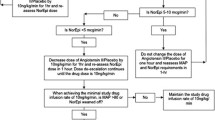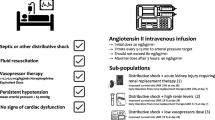Abstract
Background
Intra-abdominal hypertension (IAH) can cause high mortality. Recently, we found that IAH was associated with increased serum levels of adenosine and interleukin 10. Our present “hypothesis-generated study” was based on the abovementioned results.
Materials and methods
In this uncontrolled clinical trial, a total of 78 patients with IAH were enrolled representing a 13–20 mmHg range of intra-abdominal pressure (IAP). Patients requiring surgical abdominal decompression were excluded. Patients were treated with the following protocols: standard supportive therapy (ST, n = 38) or ST plus infusion with the adenosine receptor antagonist theophylline (T, n = 40). Over the 5-day measurement period, IAP was monitored continuously and serum adenosine concentration and other clinical and laboratory measurements were monitored daily. Mortality was followed for the first 30 days following the diagnosis of IAH.
Results
Mortality of ST patients was 55%, which is compatible to other studies. Serum adenosine concentration was found to be directly proportional to IAP. Of the 40 patients receiving T treatment, survival was 100%. An increased survival related to theophylline infusion correlated with improving serum concentrations of IL-10, urea, and creatinine, as well as 24-h urine output, fluid balance, mean arterial pressure, and O2Sat.
Conclusions
Adenosine receptor antagonism with T following IAH diagnosis resulted in markedly reduced mortality in patients with moderated IAH (<20 mmHg). Theophylline-associated mortality reduction may be related to improved renal perfusion and improved MAP, presumably caused by adenosine receptor blockade. Because this study was not a randomized controlled study, these compelling observations require further multicentric clinical confirmation.

Similar content being viewed by others
References
An G, West MA (2008) Abdominal compartment syndrome: a concise clinical review. Crit Care Med 36:1304–1310
Malbrain ML, Cheatham ML, Kirkpatrick A, Sugrue M, Parr M, De Waele J, Balogh Z, Leppäniemi A, Olvera C, Ivatury R, D’Amours S, Wendon J, Hillman K, Johansson K, Kolkman K, Wilmer A (2006) Results from the International Conference of Experts on Intra-Abdominal Hypertension and Abdominal Compartment Syndrome. I. Definitions. Int Care Med 32:1722–1732
Cheatham ML, Malbrain ML, Kirkpatrick A, Sugrue M, Parr M, De Waele J, Balogh Z, Leppäniemi A, Olvera C, Ivatury R, D’Amours S, Wendon J, Hillman K, Wilmer A (2007) Results from the International Conference of Experts on Intra-abdominal Hypertension and Abdominal Compartment Syndrome. II. Recommendations. Int Care Med 33:951–962
Walker J, Criddle LM (2003) Pathophysiology and management of abdominal compartment syndrome. Am J Crit Care 12:362–373
Moore AF, Hargest R, Martin M, Delicata RJ (2004) Intra-abdominal hypertension and the abdominal compartment syndrome. Br J Surg 91:1102–1110
Malbrain ML, Deeren D, DePotter TI (2005) Intra-abdominal hypertension in the critically ill: it is time to pay attention. Curr Opin Crit Care 11:156–171
Sugrue M, Buhkari Y (2009) Intra-abdominal pressure and abdominal compartment syndrome in acute general surgery. World J Surg 33:1123–1127
Deenichin GP (2008) Abdominal compartment syndrome. Surg Today 38:5–19
Rosin D, Rosenthal RJ (2001) Adverse hemodynamic effects of intraabdominal pressure—is it all in the head? Int J Surg Investig 2:335–345
Kopelman T, Harris C, Miller R, Arrillaga A (2000) Abdominal compartment syndrome in patients with isolated extraperitoneal injuries. J Trauma 49:744–749
Schein M, Wittmann DH, Aprahamian CC, Condon RE (1995) The abdominal compartment syndrome: the physiological and clinical consequences of elevated intra-abdominal pressure. J Am Coll Surg 180:745–753
Zs B, De Waele JJ, Malbrain ML (2007) Continuous intra-abdominal pressure monitoring. Acta Clin Belg Suppl 62:26–32
Bulyovszky I, Tóth D, Kathy S, Hajdu Z (2006) The abdominal compartment syndrome (ACS) in general surgery. Hung J Surg 59:152–159
Sebastiano AM, Ribeiro JA (2009) Adenosine receptors and the central nervous system. Handb Exp Pharmacol 193:471–534
Berne RM, Knabb RM, Ely SW, Rubio R (1983) Adenosine in the local regulation of blood flow: a brief review. Fed Proc 42:3136–3142
McCallion K, Harkin DW, Gardiner KR (2004) Role of adenosine in immunomodulation: review of the literature. Crit Care Med 32:273–277
Daly IW, Ukena D, Jacobson KA (1987) Analogues of adenosine, theophylline and caffeine: selective interactions with A1 and A2 adenosine receptors. In: Gerlach E, Becker BF (eds) Topics and perspectives in adenosine research. Springer, Berlin, pp 23–36
Olah ME, Stiles GL (1995) Adenosine receptor subtypes: characterization and therapeutic regulation. Annu Rev Pharmacol Toxicol 35:581–606
Sipka S, Kovács I, Szántó S, Szegedi G, Brugós L, Bruckner G, Szentmiklósi J (2005). Adenosine inhibits the release of interleukin-1β in activated human peripherial mononuclear cells. Cytokine 31:258–263
Sipka S, Seres T, Dinya Z, Szekanecz Z, Szentmiklósi J, Bodolay E, Szegedi G (1995) Tumour necrosis factor-α and adenosine in endotoxin shock-related cardiovascular symptoms. Mediat Inflamm 4:454–455
Keresztes T, Kovács I, Hajdu Z, Boissonneault GA, Sipka S (2010) Increased serum adenosine and interleukin 10 levels as new laboratory markers of increased intra-abdominal pressure. Langenbeck’s Arch Surg 395:969–972
The World Society of the Abdominal Compartment Syndrome (WSACS), http://www.wsacs.org, accessed November 12, 2008
Cox P (1987) Insensible water loss and its assessment in adult patients. A review. Acta Anaesthesiol Scand 31:771–776
Malbrain ML, Chiumello D, Pelosi P, Bihari D, Innes R, Ranieri VM, Del Turco M, Wilmer A, Brienza N, Malcangi V, Cohen J, Japiassu A, De Keulenaer BL, Daelemans R, Jacquet L, Laterre PF, Frank G, de Souza P, Cesana B, Gattinoni L (2005) Incidence and prognosis of intraabdominal hypertension in a mixed population of critically ill patients: a multiple-center epidemiological study. Crit Care Med 33:315–322
Phillis JW, Wu PH (1982) The effect of various centrally active drugs on adenosine uptake by the central nervous system. Comp Biochem Physiol 172:179–187
Jakob SM (2002) Splanchnic ischaemia. Crit Care 6:306–312
Barnes GE, Laine GA, Giam PY, Smith EE, Granger HJ (1985) Cardiovascular responses to elevation of intra-abdominal hydrostatic pressure. Am J Physiol 248:208–213
Shryock JC, Belardinelli L (1997) Adenosine and adenosine receptors in the cardiovascular system: biochemistry, physiology, and pharmacology. Am J Cardiol 79:2–10
Lucas DG Jr, Hendrick JW, Sample JA, Mukherjee R, Escobar GP, Smits GJ, Crawford FA Jr, Spinale FG (2002) Cardiorenal effects of adenosine subtype 1 (A1) receptor inhibition in an experimental model of heart failure. J Am Coll Surg 194:603–609
Le Moine O, Stordeur P, Schandené L, Marchant A, de Groote D, Goldman M, Devière J (1996) Adenosine enhances IL-10 secretion by human monocytes. J Immunol 156:4408–4414
Evans DB, Schenden JA, Bristol JA (1982) Adenosine receptors mediating cardiac depression. Life Sci 31:2425–2432
Spielman WS (1984) Antagonistic effect of theophyllin on the adenosine-induced decreased in rennin release. Am J Physiol Renal Physiol 247:246–251
Hedqvist P, Fredholm BB, Olundh S (1978) Antagonistic effects of theophylline and adenosine on adrenergic neuroeffector transmission in the rabbit kidney. Circ Res 43:592–598
Steffen RP, O’Neill JT, Haddy FJ (1988) Effect of theophylline on renal vasoactivity of acetate and adenosine. J Cardiovasc Pharmacol 11:682–686
Joannidis M (2007) Medical therapy of acute kidney injury. Acta Clin Belg Suppl 2:353–356
Bidani AK, Churchill PC (1983) Glycerol-induced acute renal failure in rats. Can J Physiol Pharmacol 61:567–571
Bowmer CJ, Collis MG, Yates MS (1986) Effect of the adenosine antagonist 8-phenyltheophylline on glycerol-induced acute renal failure in the rat. Br J Pharmacol 88:205–212
Capogrossi MC, Holdiness MR, Israili ZH (1982) Determination of adenosine in normal human plasma and serum by high performance liquid chromatography. J Chromatogr 227:168–173
Eltzschig HK, Thompson LF, Karhausen J, Cotta RJ, Ibla JC, Robson SC, Colgan SP (2004) Endogenous adenosine produced during hypoxia attenuates neutrophil accumulation: coordination by extracellular nucleotide metabolism. Blood 104:3986–3992
Lin J-J, Churchill PC, Bidani AK (1986) Effect of theophylline on the initiation phase of postischemic acute renal failure in rats. J Lab Clin Med 108:150–154
Acknowledgments
The authors thank Dr. Tamás Keresztes for providing the adenosine and to Ildikó Kovács for performing the IL-10 measurements in this work. This work was supported by the research grant of Hungarian Ministry of Health (ETT 150/2006) and OTKA 71883.
Conflicts of interest
None.
Author information
Authors and Affiliations
Corresponding author
Rights and permissions
About this article
Cite this article
Bodnár, Z., Szentkereszty, Z., Hajdu, Z. et al. Beneficial effects of theophylline infusions in surgical patients with intra-abdominal hypertension. Langenbecks Arch Surg 396, 793–800 (2011). https://doi.org/10.1007/s00423-011-0808-5
Received:
Accepted:
Published:
Issue Date:
DOI: https://doi.org/10.1007/s00423-011-0808-5




